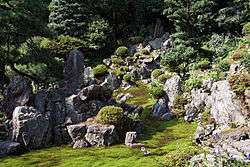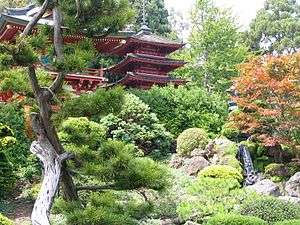Rock garden


A rock garden, also known as a rockery or an alpine garden, is a type of small field or plot of ground designed to feature and emphasize extensive use of rocks or stones and occasionally boulders, along with a few plants native to rocky or alpine environments.
Plants commonly found in rock gardens are small as they typically do not grow larger than 6 meters in height. So as to not cover up the rocks, they may be grown in containers, or in the ground. The kinds of plants usually are types which prefer well-drained soil and less water.
The usual form of a rock garden is a pile of rocks, large and small, aesthetically arranged, and with small gaps between, where the plants will be rooted. Some rock gardens incorporate bonsai.
Some rock gardens are designed and built to look like natural outcrops of bedrock. Stones are aligned to suggest a bedding plane and plants are often used to conceal the joints between the stones. This type of rockery was popular in Victorian times, often designed and built by professional landscape architects. The same approach is sometimes used in modern campus or commercial landscaping, but can also be applied in smaller private gardens.
The Japanese rock garden (which in the West is often referred to as a Zen garden) is a special kind of rock garden with few plants.
Rock gardens have become increasingly popular as landscape features in tropical countries such as Thailand.[1] The combination of wet weather and heavy shade trees, along with the use of heavy plastic liners to stop unwanted plant growth,[2] has made this type of arrangement ideal for both residential and commercial gardens due to its easier maintenance and drainage.[3]
History
Although the use of rocks as decorative and symbolic elements in gardens can be traced back to very early Chinese and Japanese gardens, rock gardens dedicated to growing alpine plants have a shorter history. During the age of the great plant explorers (basically the 1800s) there was great interest in the exotic discoveries being brought back to England, and people wanted to successfully grow these amazing new treasures. Although others had previously written about growing alpine plants, it was Reginald Farrer that, with the 1919 publication of his two-volume book The English Rock Garden, literally rocked the gardening world for the first time.
Gallery
-

Pool in rock garden on Edmonton campus of University of Alberta, Edmonton, Alberta, Canada.
-

Japanese rock garden, A mountain, waterfall, and gravel "river" at Daisen-in (1509–1513)
-

Kew Rock garden, Kew Gardens
See also
- Gardening
- Garden design
- Rock Garden, Chandigarh in Chandigarh, India
- Nek Chand, creator of the Rock Garden in Chandigarh, India.
- Reginald Farrer, field botanist and author of My Rock Garden.
References
- ↑ Warren, William (1996). Thai Garden Style. Singapore: Asia Books Co., Ltd.
- ↑ "Thai Rock Gardens". Thai Garden Design. Retrieved 12 February 2013.
- ↑ "Plant Maintenance a Pain? Stone Gardens Are the Way To Go!". Thai Garden Design. Retrieved 12 February 2013.
External links
| Wikimedia Commons has media related to Rock garden. |
- Alpines and Gardens
- Greek Mountain Flora
- FAQ on Rock Gardens
- The Alpine Garden, Rock Gardening on the Net
- Alpine-L mailing list
- North American Rock Garden Society homepage
- Scottish Rock Garden Club homepage

